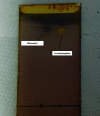Smartphone as a Portable Detector for Thin-Layer Chromatographic Determination of Some Gastrointestinal Tract Drugs
- PMID: 35847301
- PMCID: PMC9281327
- DOI: 10.1021/acsomega.2c02482
Smartphone as a Portable Detector for Thin-Layer Chromatographic Determination of Some Gastrointestinal Tract Drugs
Abstract
Thin-layer chromatography (TLC) is an effective and simple technique for screening, evaluating, and quantifying low-quality and counterfeit pharmaceutical products. Smartphones have recently been used as accessible, cheap, and portable detectors that can replace more complicated analytical detectors. In this work, we have developed a simple and sensitive TLC method utilizing a smartphone charged-coupled device (CCD) camera not only to verify and quantify some gastrointestinal tract drugs, namely, loperamide hydrochloride (LOP) and bisacodyl (BIS), but also to detect acetaminophen (ACT) as a counterfeit drug. Both drugs (LOP and BIS) were chromatographed separately on a silica gel 60 F254 plate as a stationary phase under previously reported chromatographic conditions, using ethyl acetate:methanol:ammonium hydroxide (24:3:1, by volume) and ethyl acetate:methanol:glacial acetic acid (85:10:5, by volume) as developing systems to determine LOP and BIS, respectively. Universal stains, namely, iodine vapors and vanillin, were used to visualize the spots on the TLC plates to get a visual image using the smartphone camera and a spotlight as an illumination source with no need for a UV illumination source. The spot intensity was calculated using a commercially available smartphone application for quantitative analysis of the studied drugs utilizing ″acetaminophen″ as an example of a counterfeit substance. Rf values were calculated using the recorded images and found to be 0.77, 0.79, and 0.74 for LOP, BIS, and ACT, respectively, providing drug identity. Linear calibration curves using the smartphone-TLC method were obtained between the luminance and the corresponding concentrations over the ranges of 2.00-10.00 μg/mL and 1.00-10.00 μg/mL with limits of detection of 0.57 and 0.10 μg/mL for LOP and BIS, respectively. The suggested method was validated according to the International Conference of Harmonization (ICH) guidelines. The method was then successfully applied for the qualitative and quantitative determination of LOP or BIS as an example for gastrointestinal tract drugs in pure form and in their pharmaceutical dosage formulations. The proposed method is considered as a perfect alternative to traditional reported densitometric methods due to its simplicity, easy application, and inexpensiveness. No previously reported methods utilizing smartphones have been published for the determination of the studied drugs. The developed approach is considered the first TLC method using smartphones for the determination of some gastrointestinal tract drugs in their pure form and in pharmaceutical formulations.
© 2022 The Authors. Published by American Chemical Society.
Conflict of interest statement
The authors declare no competing financial interest.
Figures



Similar articles
-
TLC-smartphone in antibiotics determination and low-quality pharmaceuticals detection.RSC Adv. 2021 May 26;11(31):19196-19202. doi: 10.1039/d1ra01346g. eCollection 2021 May 24. RSC Adv. 2021. PMID: 35478607 Free PMC article.
-
TLC- smartphone for ofloxacin and dexamethasone determination in pharmaceutical formulation and rabbit aqueous humor.J Chromatogr B Analyt Technol Biomed Life Sci. 2025 Mar 15;1254:124485. doi: 10.1016/j.jchromb.2025.124485. Epub 2025 Jan 30. J Chromatogr B Analyt Technol Biomed Life Sci. 2025. PMID: 39919408
-
Stability-indicating TLC-densitometric method for simultaneous determination of paracetamol and chlorzoxazone and their toxic impurities.J Chromatogr Sci. 2013 Feb;51(2):187-91. doi: 10.1093/chromsci/bms125. Epub 2012 Jul 26. J Chromatogr Sci. 2013. PMID: 22843763
-
Innovative thin-layer chromatographic method combined with fluorescence detection for specific determination of Febuxostat: Application in biological fluids.Talanta. 2018 Jan 1;176:318-328. doi: 10.1016/j.talanta.2017.08.051. Epub 2017 Aug 18. Talanta. 2018. PMID: 28917757
-
An eco-friendly smartphone based HPTLC method versus conventional densitometric one for determination of Naltrexone and Bupropion.BMC Chem. 2024 Sep 23;18(1):185. doi: 10.1186/s13065-024-01285-1. BMC Chem. 2024. PMID: 39313836 Free PMC article.
Cited by
-
A novel smartphone HPTLC assaying platform versus traditional densitometric method for simultaneous quantification of alfuzosin and solifenacin in their dosage forms as well as monitoring content uniformity and drug residues on the manufacturing equipment.RSC Adv. 2023 Apr 14;13(17):11642-11651. doi: 10.1039/d3ra01211e. eCollection 2023 Apr 11. RSC Adv. 2023. PMID: 37063718 Free PMC article.
References
-
- Hussain I.; Ahamad K.; Nath P. Water turbidity sensing using a smartphone. RSC Adv. 2016, 6, 22374–22382. 10.1039/C6RA02483A. - DOI
-
- Zarzycki P. K. Staining and Derivatization Techniques for Visualization in Planar Chromatography. Instrumental Thin-Layer Chromatography 2015, 191–237. 10.1016/B978-0-12-417223-4.00008-X. - DOI
-
- Warren F. Handbook of Pharmaceutical Excipients. AJHP 1987, 44, 1946–1948. 10.1093/ajhp/44.8.1946. - DOI
-
- Lavrijsen K.; Van Dyck D.; Van Houdt J.; Hendrickx J.; Monbaliu J.; Woestenborghs R.; Meuldermans W.; Heykants J. Reduction of the prodrug loperamide oxide to its active drug loperamide in the gut of rats, dogs, and humans. Drug Metab. Dispos. 1995, 23, 354–362. - PubMed
LinkOut - more resources
Full Text Sources
Miscellaneous

